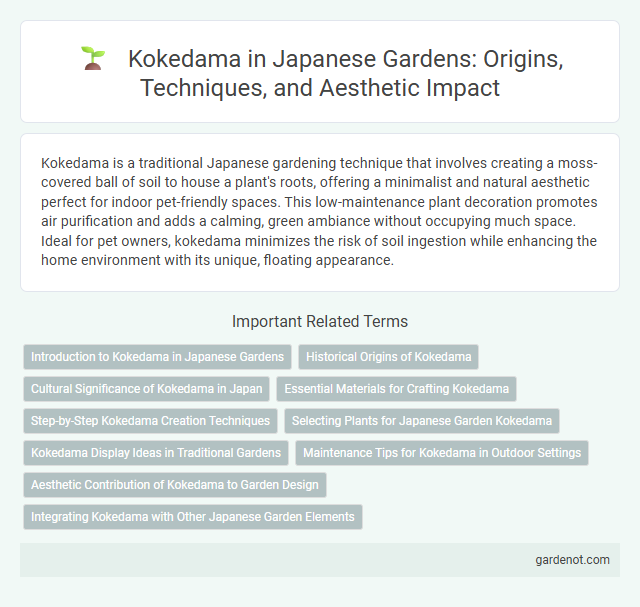Kokedama is a traditional Japanese gardening technique that involves creating a moss-covered ball of soil to house a plant's roots, offering a minimalist and natural aesthetic perfect for indoor pet-friendly spaces. This low-maintenance plant decoration promotes air purification and adds a calming, green ambiance without occupying much space. Ideal for pet owners, kokedama minimizes the risk of soil ingestion while enhancing the home environment with its unique, floating appearance.
Introduction to Kokedama in Japanese Gardens
Kokedama, a traditional Japanese horticultural art, involves creating moss-covered soil balls that serve as unique, living planters. Originating from the practice of bonsai, Kokedama emphasizes simplicity and natural beauty, reflecting the Japanese aesthetic principles of wabi-sabi and harmony with nature. This technique enhances Japanese gardens by offering a portable and minimalist way to display plants, seamlessly blending greenery with architectural elements.
Historical Origins of Kokedama
Kokedama, also known as "moss ball," originated in the Japanese horticultural tradition during the Edo period (1603-1868). It evolved from the practice of bonsai and kusamono, emphasizing minimalist aesthetics and natural beauty in confined spaces. This art form blends the principles of wabi-sabi, celebrating impermanence and simplicity through its moss-covered root ball design.
Cultural Significance of Kokedama in Japan
Kokedama, often referred to as the "moss ball," holds deep cultural significance in Japan as it embodies the principles of wabi-sabi, emphasizing simplicity and the beauty of imperfection. This horticultural art form reflects the traditional Japanese reverence for nature and the seamless integration of greenery into both indoor and outdoor spaces. Growing in popularity, Kokedama serves as a living symbol of mindfulness, harmony, and a connection to the natural world in Japanese culture.
Essential Materials for Crafting Kokedama
Kokedama crafting requires essential materials such as high-quality bonsai soil, a specific blend of akadama and peat moss, and a fragrant moss layer like sphagnum or sheet moss. A strong, moisture-retentive base of akadama soil ensures proper aeration and root health for plants such as ferns and mosses. Additionally, natural twine or nylon string is crucial for securely binding the moss ball, creating the signature floating garden aesthetic of traditional Japanese kokedama.
Step-by-Step Kokedama Creation Techniques
Start by selecting a suitable plant and gently removing excess soil from its roots. Prepare a mixture of akadama soil, peat moss, and bonsai soil to form a firm, moist ball around the roots. Wrap the soil ball with sphagnum moss, then secure it tightly using natural jute twine, ensuring the plant is stable and ready for display or hanging.
Selecting Plants for Japanese Garden Kokedama
Selecting plants for Japanese garden Kokedama requires choosing species with compact root systems, such as ferns, mosses, or small tropical plants like Fittonia and Peperomia. These plants thrive in the limited soil volume of the moss ball and maintain the aesthetic balance typical of traditional Japanese gardens. Proper moisture control and light conditions tailored to the plant species ensure healthy growth and longevity of the Kokedama display.
Kokedama Display Ideas in Traditional Gardens
Kokedama display ideas in traditional Japanese gardens emphasize minimalism and natural harmony by suspending moss balls from wooden beams or arranging them on stone slabs to highlight their organic textures. Placing kokedama on low wooden tables near koi ponds integrates the display seamlessly with water features, enhancing the garden's serene ambiance. Incorporating weathered ceramic trays or bamboo stands further complements the rustic aesthetic while providing structured contrast to the soft moss spheres.
Maintenance Tips for Kokedama in Outdoor Settings
Kokedama in outdoor settings require consistent moisture to prevent the moss ball from drying out, ideally watering once or twice a week depending on the climate and season. Placing Kokedama in shaded or semi-shaded areas protects the delicate moss from direct sunlight and helps maintain humidity. Regularly trimming the plant and rotating the Kokedama ensures balanced growth and prevents moss deterioration.
Aesthetic Contribution of Kokedama to Garden Design
Kokedama enhances Japanese garden design by integrating natural textures and organic forms that evoke tranquility and harmony. Its moss-covered balls create focal points that complement traditional elements like stone lanterns and koi ponds, enriching the overall sensory experience. The minimalist aesthetic of kokedama aligns with Wabi-sabi principles, emphasizing simplicity and the beauty of imperfection.
Integrating Kokedama with Other Japanese Garden Elements
Kokedama seamlessly integrates with traditional Japanese garden elements such as stone lanterns, bamboo fences, and water basins, enhancing the overall aesthetic harmony. Its moss-covered soil ball design complements the natural textures and minimalist style of other garden components, creating a unified and tranquil environment. Placing Kokedama near koi ponds or under maple trees amplifies the sensory experience by combining visual appeal with soothing natural sounds and seasonal color variations.
Kokedama Infographic

 gardenot.com
gardenot.com